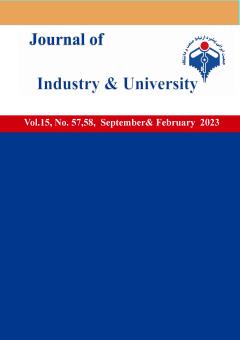Designing a Model of Internal Relations in the Insurance Industry Using Interpretive Structural Modeling (ISM)
Subject Areas : عمومى
pegah Madah Rudsari
1
![]() ,
Davood Kiakojouri
2
,
Davood Kiakojouri
2
![]() ,
Mehran Mokhtari Bayekolaei
3
,
Mehran Mokhtari Bayekolaei
3
![]()
1 - PhD student in public administration majoring in organizational behavior; Chalous Branch, Islamic Azad University, Chalous, Iran
2 - Associate Professor of Public Administration Department; Chalous Branch, Islamic Azad University, Chalous, Iran
3 - Associate Professor of Public Administration Department; Chalous Branch, Islamic Azad University, Chalous, Iran
Keywords: Structural Capital, Human Capital, Relational Capital, Insurance Industry,
Abstract :
Intellectual capital is a combination of intangible assets, human assets and infrastructures that enable the organization to perform its tasks. Structural, human, and relational capitals are the components of intellectual capital, which are a combination of intangible assets, human assets, and infrastructures that enable the organization to perform its duties. Based on this, the main goal of the current research is to design internal relationships between structural, human and relational capitals in the insurance industry using Interpretive Structural Modeling (ISM). The method in this research is quantitative (descriptive-survey) and by using the snowball method, 15 experts in the field of public administration and organizational behavior who were effective in the field of intellectual capital and social capital and also had management experience in the insurance industry as The statistical sample of the research was selected and the internal relationships between the research components were identified by the Interpretive Structural Modeling (ISM) method
The findings of the research showed that the dimension of human capital (including communication skills, work experience and tacit knowledge of people) as the basis of the model affects all other dimensions and is located at the bottom level, which is the basis of intellectual capital and an essential element. It is considered in the implementation of its duties. At the middle level of the dimension of relational capital (including trust and honesty, informal participation, political participation, social participation, economic participation) and at the last level is structural capital (including communication and network links and network capitals), which two other dimensions have an effect on it. As a result, the structural, human and relational capitals are a set of knowledge, information, intellectual assets, experience, competition and learning of the organization, which managers, paying attention to this factor, can be a suitable platform for promoting capitals. Provide an idea in the organization.
1. بهرامی، سوسن، تحلیل روابط چندگانه سرمایه فکری و نوآوری سازمانی در آموزش عالی. فصلنامه پژوهش و برنامه ریزی در آموزش عالی(1390)، دوره 13 شماره 61.
2. تحریری فرد، احمد و شریفی، سید حمید و پوریان، علیرضا. مدیریت سرمایه فکری و تاثیر آن بر عملکرد سازمان، سومین همایش ملی ایده¬های کاربردی در علوم تربیتی، روانشناسی و مطالعات فرهنگی، بوشهر(1402).
3. رئیس¬پور، علی، آسیب شناسی مولفه های نظام سرمایه فکری و بکارگیری آن در سازمان های دولتی ایران، پنجمین کنفرانس بین المللی علوم مدیریت و حسابداری، تهران، موسسه آموزشی عالی مهر اروند و مرکز راهکارهای دستیابی به توسعه پایدار(1398).
4. عشقی، محمد، بررسی تأثير مولفه های سرمایه فکری بر عملکرد مالی سازمان. فصلنامه رویکردهای پژوهشی نوین در مدیریت و حسابداری(1399). سال چهارم، شماره 50.
5. مرادی شهدادی، خسرو؛ انواری رستمی، علی اصغر، رنجبر، محمد حسین و صادقی شریف، سید جلال، تبیین نقش سرمایه فکري در کاهش احتمال ورشکستگی شرکت ها: شواهدي از بورس اوراق بهادار تهران(1396). پژوهش هاي مدیریت منابع سازمانی دوره 7، شماره 4.
6. نیکوفر، ندا و آقاداوود، سیدرسول، بررسی اثرات سرمایه ساختاری بر سرمایه رابطه ای با در نظر گرفتن عملکرد سازمانی و سرمایه انسانی در بانک صادرات استان چهارمحال و بختیاری(1400).
7. Bontis, N, Intellectual capital: an exploratory study that develops measures and models. Management Decision, (1998). 36 (2), 63-76.
8. Brennan, N. and Connell, B. "Intectual capital: current issues and policy implications", Journal of Intellectual Capital, (2009). vol.1, No. 3, pp. 206-240.
9. Conibano, L." Accounting for intangibles: a literature review", The Journal of Accounting Literature. (2013). Vol. 19, pp. 102-300.
10. Hsu, Y and W. Fang. “Intellectual capital and new product development performance: The mediating role of organizational learning capability”, Technological Forecasting and Social Change, (2009). pp. 664-677.
11. Huang, and Y.-C. Jim Wu. “Intellectual capital and knowledge productivity: the Taiwan biotech industry”, Management decision, (2010). pp. 580-599
12. Linda, M.R, Rasyid, R and Megawati, M. ntellectual Capital and Firm’s Performance: An Empirical Evidence from Islamic Bank in Indonesia, Research Reviews: Journal of Social Sciences, (2018). Volume 3.
13. Lu, W & Wang, and Q.L. Kweh. “Intellectual capital and performance in the Chinese life insurance industry” Omega, (2015). pp. 65-74.
14. Noor, A & Nawangsari, L. The Effect of Intellectual Capital on Organizational Sustainability through Knowledge Management on Employees of Pd Dharma Jaya in Regionally Owned Enterprises of Dki Jakarta. European Journal of Business and Management Research. (2021).
15. Olarewaju, O & Sthembiso, T. Intellectual capital and financial performance of South African development community’s general insurance companies. Department of Management Accounting, Faculty of Accounting and Informatics, Durban University of Technology, South Africa. (2021).
16. Pınar, Sevcan & Mine Afacan Fındıklı & Ali Mertcan Köse. Relationship between Resource Dependency Sub-dimensions and Relationship between Resource Dependency Sub-dimensions and Innovation Performance. Procedia Computer Science 158 (2019) 557–564.
17. Radaelli, G. “Intellectual capital and knowledge sharing: the mediating role of organisational knowledgesharing climate”, Knowledge Management Research & Practice, (2012). pp. 342-352.


